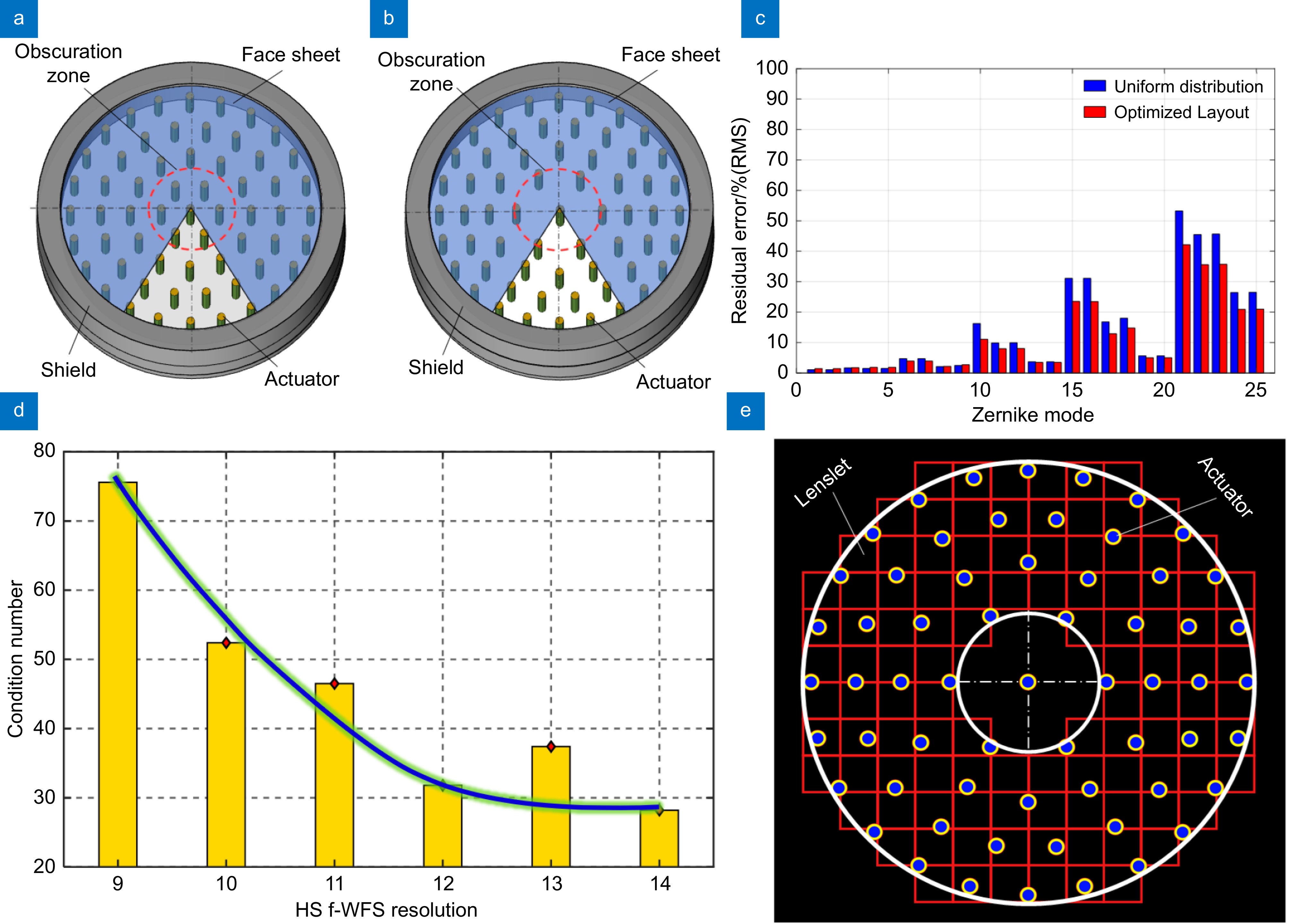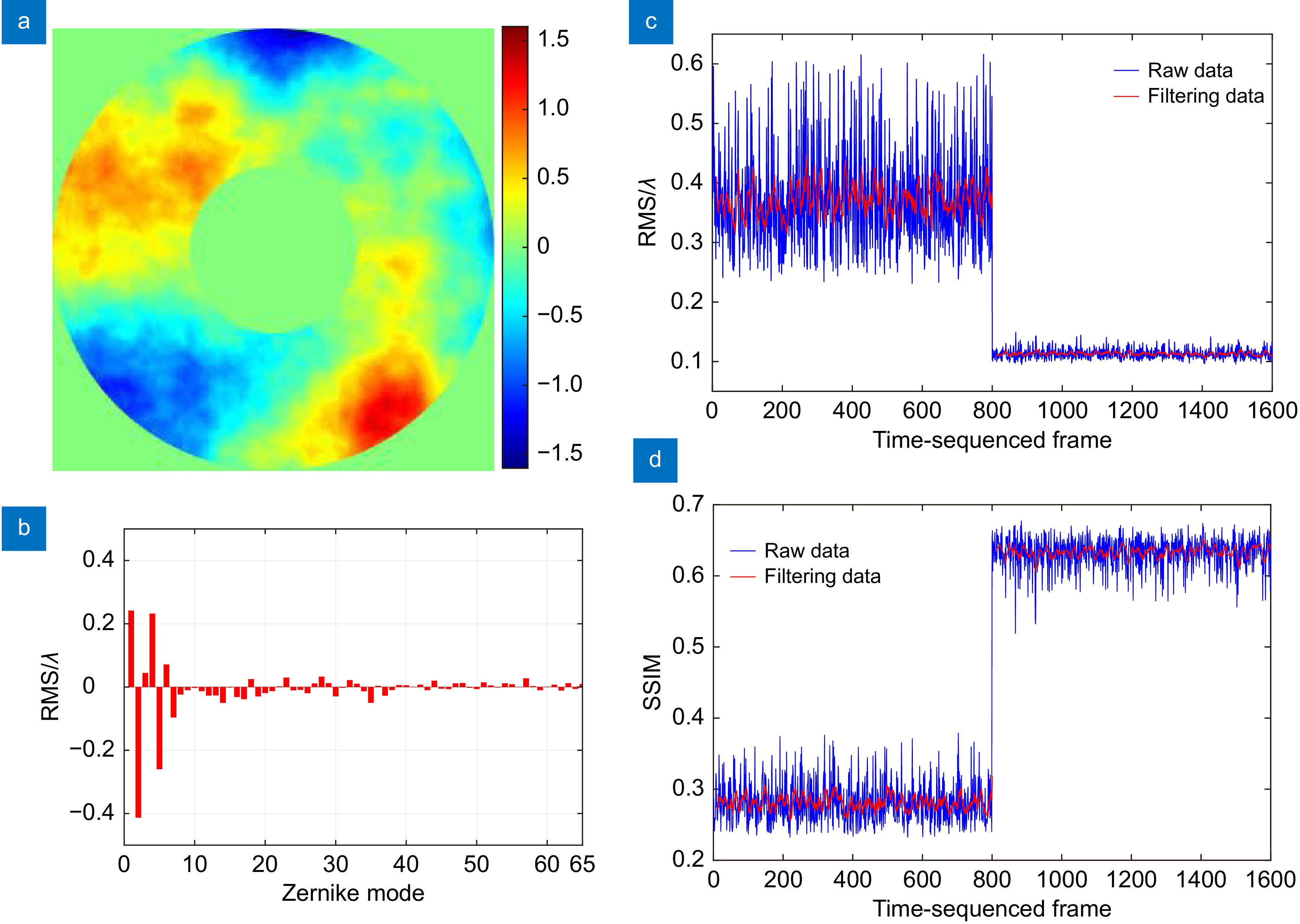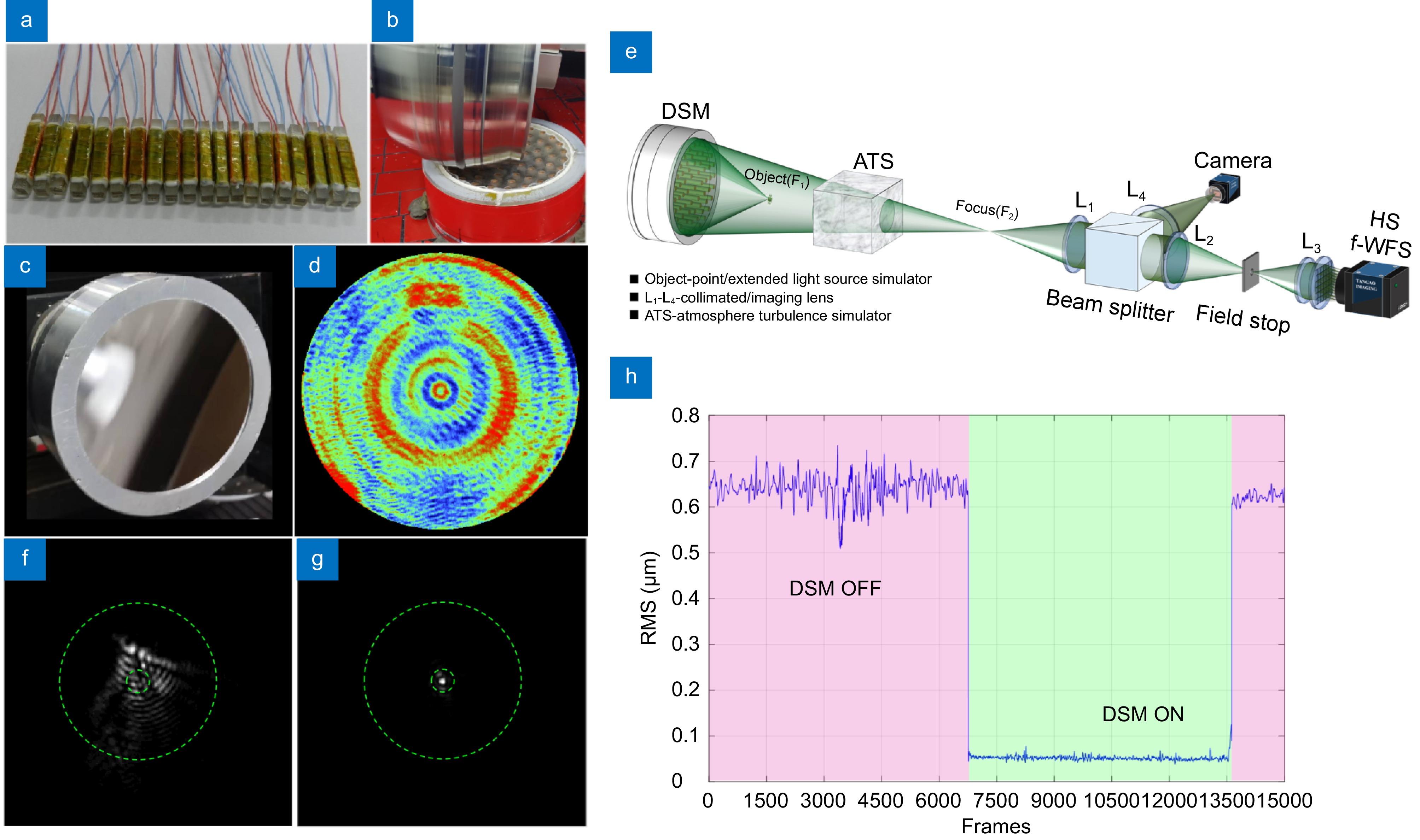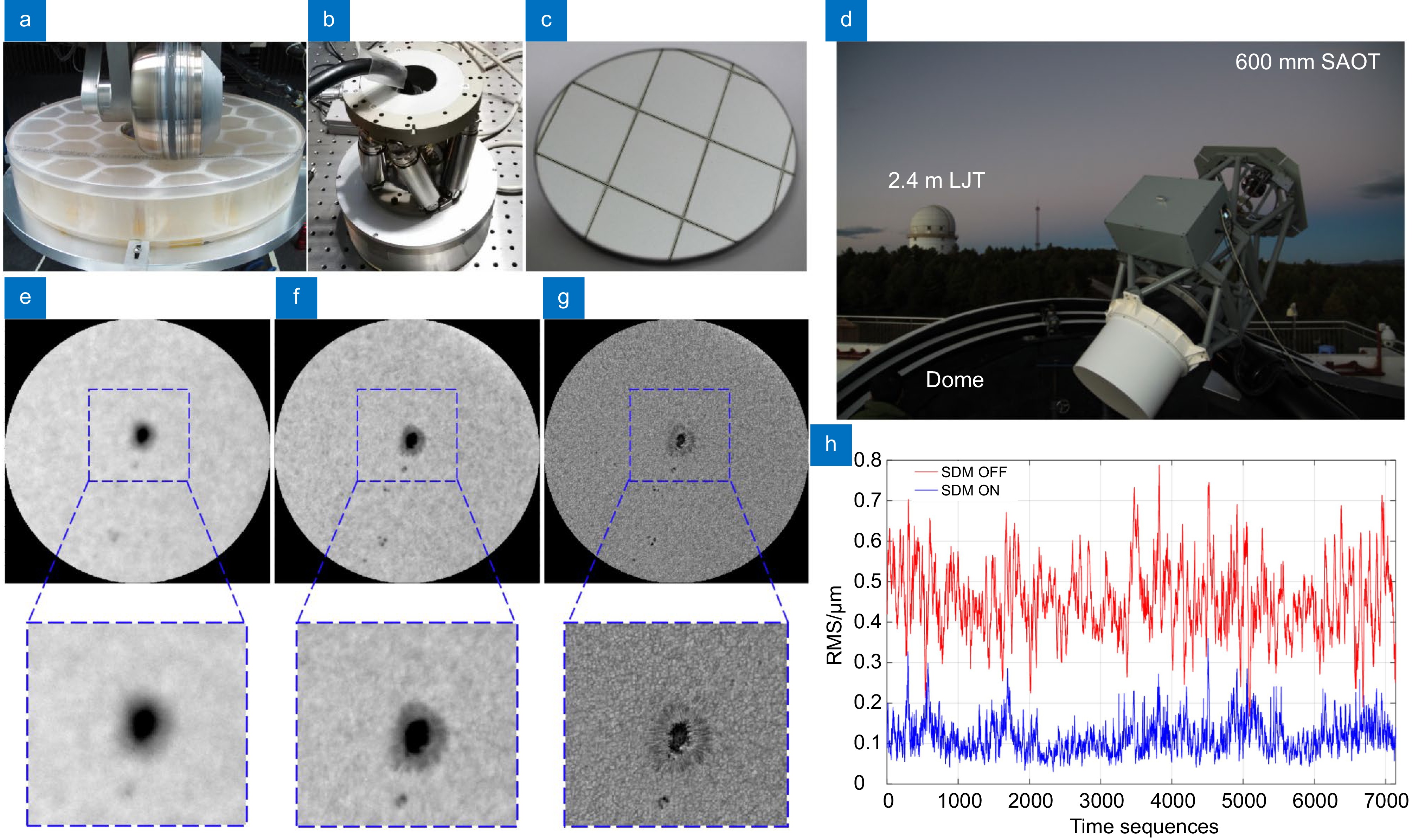| Citation: | Gu NT, Chen H, Tang A et al. Embedded solar adaptive optics telescope: achieving compact integration for high-efficiency solar observations. Opto-Electron Adv 8, 250025 (2025). doi: 10.29026/oea.2025.250025 |
Embedded solar adaptive optics telescope: achieving compact integration for high-efficiency solar observations
-
Abstract
Adaptive optics (AO) has significantly advanced high-resolution solar observations by mitigating atmospheric turbulence. However, traditional post-focal AO systems suffer from external configurations that introduce excessive optical surfaces, reduced light throughput, and instrumental polarization. To address these limitations, we propose an embedded solar adaptive optics telescope (ESAOT) that intrinsically incorporates the solar AO (SAO) subsystem within the telescope's optical train, featuring a co-designed correction chain with a single Hartmann-shack full-wavefront sensor (HS f-WFS) and a deformable secondary mirror (DSM). The HS f-WFS uses temporal-spatial hybrid sampling technique to simultaneously resolve tip-tilt and high-order aberrations, while the DSM performs real-time compensation through adaptive modal optimization. This unified architecture achieves symmetrical polarization suppression and high system throughput by minimizing optical surfaces. A 600 mm ESAOT prototype incorporating a 12×12 micro-lens array HS f-WFS and 61-actuator piezoelectric DSM has been developed and successfully conducted on-sky photospheric observations. Validations including turbulence simulations, optical bench testing, and practical observations at the Lijiang observatory collectively confirm the system's capability to maintain about λ/10 wavefront error during active region tracking. This architectural breakthrough of the ESAOT addresses long-standing SAO integration challenges in solar astronomy and provides scalability analyses confirming direct applicability to the existing and future large solar observation facilities. -

-
References
[1] Rimmele T, Keil S, Dooling D. Building the world’s largest optical solar telescope. SPIE (2007). [2] MacTaggart D, Prior C, Raphaldini B et al. Direct evidence that twisted flux tube emergence creates solar active regions. Nat Commun 12, 6621 (2021). doi: 10.1038/s41467-021-26981-7 [3] Stangalini M, Verth G, Fedun V et al. Large scale coherent magnetohydrodynamic oscillations in a sunspot. Nat Commun 13, 479 (2022). doi: 10.1038/s41467-022-28136-8 [4] Yuan D, Fu LB, Cao WD et al. Transverse oscillations and an energy source in a strongly magnetized sunspot. Nat Astron 7, 856–866 (2023). doi: 10.1038/s41550-023-01973-3 [5] Stangalini M. Wave energy in the solar atmosphere. Nat Astron 7, 761–762 (2023). doi: 10.1038/s41550-023-01955-5 [6] Clery D. ‘Campfires’ may drive heating of solar atmosphere. Science 372, 557–558 (2021). doi: 10.1126/science.372.6542.557 [7] Yan XL, Xue ZK, Jiang CW et al. Fast plasmoid-mediated reconnection in a solar flare. Nat Commun 13, 640 (2022). doi: 10.1038/s41467-022-28269-w [8] Ishikawa R, Bueno JT, Del Pino Alemán T et al. Mapping solar magnetic fields from the photosphere to the base of the corona. Sci Adv 7, eabe8406 (2021). doi: 10.1126/sciadv.abe8406 [9] Jenkins JM, Keppens R. Resolving the solar prominence/filament paradox using the magnetic Rayleigh-Taylor instability. Nat Astron 6, 942–950 (2022). doi: 10.1038/s41550-022-01705-z [10] Hotta H, Kusano K. Solar differential rotation reproduced with high-resolution simulation. Nat Astron 5, 1100–1102 (2021). doi: 10.1038/s41550-021-01459-0 [11] Dong CF, Wang L, Huang YM et al. Reconnection-driven energy cascade in magnetohydrodynamic turbulence. Sci Adv 8, eabn7627 (2022). doi: 10.1126/sciadv.abn7627 [12] Boucheron LE, Vincent T, Grajeda JA et al. Solar active region magnetogram image dataset for studies of space weather. Sci Data 10, 825 (2023). doi: 10.1038/s41597-023-02628-8 [13] Wheatland MS. Real-time solar coronal modelling. Nat Astron 7, 1150–1151 (2023). doi: 10.1038/s41550-023-02085-8 [14] Li KF, Tung KK. Solar cycle as a distinct line of evidence constraining earth’s transient climate response. Nat Commun 14, 8430 (2023). doi: 10.1038/s41467-023-43583-7 [15] von der Lühe O, Schmidt W, Soltau D et al. GREGOR: a 1.5m telescope for solar research. Astron Nachr 322, 353–360 (2001). doi: 10.1002/1521-3994(200112)322:5/6<353::AID-ASNA353>3.0.CO;2-Z [16] Jiang P, Gan HQ, Yao R et al. FAST: the five-hundred-meter aperture spherical radio telescope. Engineering 28, 21–25 (2023). doi: 10.1016/j.eng.2023.04.001 [17] Leslie M. Webb space telescope hits its stride, dazzling astronomers. Engineering 22, 3–6 (2023). doi: 10.1016/j.eng.2023.01.003 [18] Tritschler A, Rimmele TR, Berukoff S et al. Daniel K. Inouye solar telescope: high-resolution observing of the dynamic sun. Astron Nachr 337, 1064–1069 (2016). doi: 10.1002/asna.201612434 [19] Wang HM, Cao WD, Liu C et al. Witnessing magnetic twist with high-resolution observation from the 1.6-m new solar telescope. Nat Commun 6, 7008 (2015). doi: 10.1038/ncomms8008 [20] Yurchyshyn V, Cao WD, Abramenko V et al. Rapid evolution of type II spicules observed in Goode solar telescope on-disk Hα images. Astrophys J Lett 891, L21 (2020). doi: 10.3847/2041-8213/ab7931 [21] Tagle CD, Collados M, Lopez R et al. First light of the integral field unit of GRIS on the GREGOR solar telescope. J Astron Instrum 11, 2250014 (2022). doi: 10.1142/S2251171722500143 [22] Rao CH, Gu NT, Rao XJ et al. First light of the 1.8-m solar telescope-CLST. Sci China Phys Mech Astron 63, 109631 (2020). doi: 10.1007/s11433-019-1557-3 [23] Gu NT, Li C, Cheng YT et al. Thermal control for light-weighted primary mirrors of large ground-based solar telescopes. J Astron Telesc Instrum Syst 5, 014005 (2019). [24] Cai YF, Yang X, Xiang YY et al. The co-alignment of winged Hα data observed by the new vacuum solar telescope. Res Astron Astrophys 22, 065010 (2022). doi: 10.1088/1674-4527/ac69b9 [25] Matthews SA, Collados M, Mathioudakis M et al. The European solar telescope (EST). Proc SPIE 9908, 990809 (2016). [26] Liu Z, Deng YY, Jin ZY et al. Introduction to the Chinese giant solar telescope. Proc SPIE 8444, 844405 (2012). doi: 10.1117/12.926033 [27] Fu Y, Yuan S, Jin ZY et al. Polarization optical design of 8-meter Chinese giant solar telescope. Acta Astron Sin 64, 8 (2023). [28] Fang C, Gu BZ, Yuan XY et al. 2.5m wide-field and high-resolution telescope. Sci China Phys Mech Astron 49, 059603 (2019). doi: 10.1360/SSPMA2018-00313 [29] Hasan SS, Soltau D, Kärcher H et al. NLST: India’s national large solar telescope. Astron Nachr 331, 628–635 (2010). doi: 10.1002/asna.201011389 [30] Rao CH, Zhu L, Zhang LQ et al. Development of solar adaptive optics. Opto-Electron Eng 45, 170733 (2018). [31] Berkefeld T, Schmidt D, Soltau D et al. The GREGOR adaptive optics system. Astron Nachr 333, 863–871 (2012). doi: 10.1002/asna.201211739 [32] Femenía-Castella B, Cagigal MN, Cabrera MB et al. Adaptive optics at the European solar telescope: status and future developments. Proc SPIE 12185, 121851Z (2022). [33] Rimmele TR, Radick RR. Solar adaptive optics at the national solar observatory. Proc SPIE 3353, 72–81 (1998). doi: 10.1117/12.321734 [34] Shumko S, Gorceix N, Choi S et al. AO-308: the high-order adaptive optics system at big bear solar observatory. Proc SPIE 9148, 914835 (2014). [35] Rao CH, Zhu L, Rao XJ et al. First generation solar adaptive optics system for 1-m new vacuum solar telescope at Fuxian solar observatory. Res Astron Astrophys 16, 023 (2016). [36] Rao CH, Zhu L, Rao XJ et al. Instrument description and performance evaluation of a high-order adaptive optics system for the 1m new vacuum solar telescope at Fuxian solar observatory. Astrophys J 833, 210 (2016). doi: 10.3847/1538-4357/833/2/210 [37] Rao CH, Zhu L, Gu NT et al. A high-resolution multi-wavelength simultaneous imaging system with solar adaptive optics. Astron J 154, 143 (2017). doi: 10.3847/1538-3881/aa84b4 [38] Rimmele TR, Warner M, Keil SL et al. The Daniel K. Inouye solar telescope-observatory overview. Sol Phys 295, 172 (2020). doi: 10.1007/s11207-020-01736-7 [39] Das S, Rao N, Phanindra DVS et al. SolarAccel: FPGA accelerated 2D cross-correlation of digital images: application to solar adaptive optics. J Astrophys Astron 45, 16 (2024). doi: 10.1007/s12036-024-10003-1 [40] Zhu L, Gu NT, Chen SQ et al. Real time controller for 37-element low-order solar adaptive optics system at 1m new vacuum solar telescope. Proc SPIE 8415, 84150V (2012). doi: 10.1117/12.977864 [41] Martin Y, Rodriguez-Ramos LF, García J et al. FPGA-based real time processing of the plenoptic wavefront sensor for the European solar telescope (EST). In 2010 VI Southern Programmable Logic Conference (SPL) 87–92 (IEEE, 2010). http://doi.org/10.1109/SPL.2010.5483032. [42] Brusa G, Riccardi A, Wildi FP et al. MMT adaptive secondary: first AO closed-loop results. Proc SPIE 5169, 26–36 (2003). [43] Salinari P, Sandler DG. High-order adaptive secondary mirrors: where are we. Proc SPIE 3353, 742–753 (1998). doi: 10.1117/12.321691 [44] Johnson JA, Vaz A, Montoya M et al. Tuning the MAPS adaptive secondary mirror: actuator control, PID tuning, power spectra, and failure diagnosis. Proc SPIE 13149, 131490H (2024). [45] Esposito S, Tozzi A, Ferruzzi D et al. First-light adaptive optics system for large binocular telescope. Proc SPIE 4839, 164–173 (2003). doi: 10.1117/12.458866 [46] Esposito S, Tozzi A, Puglisi A et al. First light AO system for LBT: toward on-sky operation. Proc SPIE 6272, 62720A (2006). [47] Riccardi A, Xompero M, Briguglio R et al. The adaptive secondary mirror for the large binocular telescope: optical acceptance test and preliminary on-sky commissioning results. Proc SPIE 7736, 77362C (2010). doi: 10.1117/12.858229 [48] Arsenault R, Biasi R, Gallieni D et al. A deformable secondary mirror for the VLT. Proc SPIE 6272, 62720V (2006). doi: 10.1117/12.672879 [49] Hibon P, Duhoux P. Improving the telescope guiding with field stabilization on the very large telescope/unit telescopes. J Astron Telesc Instrum Syst 9, 027002 (2023). [50] https://giantmagellan.org/adaptive-secondary-optics/. [51] Hinz PM, Bowens-Rubin R, Baranec C et al. Developing adaptive secondary mirror concepts for the APF and W. M. Keck observatory based on HVR technology. Proc SPIE 11448, 114485U (2020). [52] Guo YM, Chen KL, Zhou JH et al. High-resolution visible imaging with piezoelectric deformable secondary mirror: experimental results at the 1.8-m adaptive telescope. Opto-Electron Adv 6, 230039 (2023). doi: 10.29026/oea.2023.230039 [53] Thomas S, Fusco T, Tokovinin A et al. Comparison of centroid computation algorithms in a Shack-Hartmann sensor. Mon Not R Astron Soc 371, 323–336 (2006). doi: 10.1111/j.1365-2966.2006.10661.x [54] Mocci J, Busato F, Bombieri N et al. Efficient implementation of the Shack–Hartmann centroid extraction for edge computing. J Opt Soc Am A 37, 1548–1556 (2020). doi: 10.1364/JOSAA.401376 [55] Zhou ZC, Zhang LQ, Zhu L et al. Comparison of correlation algorithms with correlating Shack–Hartmann wave-front images. Proc SPIE 10026, 100261B (2016). [56] Ke ZB, Zhang LQ, Yang Y et al. Performance analysis and optimization of solar multiconjugate adaptive optics systems. Mon Not R Astron Soc 530, 307–317 (2024). doi: 10.1093/mnras/stae347 [57] Yang Y, Zhang L, Yan N et al. Ground-layer adaptive optics for the 2.5 m wide-field and high-resolution solar telescope. Res Astron Astrophys 24, 035018 (2024). doi: 10.1088/1674-4527/ad21d4 [58] Cui ZJ, Qi WF, Liu YX. A fast image template matching algorithm based on normalized cross correlation. J Phys Conf Ser 1693, 012163 (2020). doi: 10.1088/1742-6596/1693/1/012163 [59] Liu SH, Zhong H, Li YQ et al. Fast and highly accurate zonal wavefront reconstruction from multi-directional slope and curvature information using subregion cancelation. Appl Sci 14, 3476 (2024). doi: 10.3390/app14083476 [60] Mochi I, Goldberg KA. Modal wavefront reconstruction from its gradient. Appl Opt 54, 3780–3785 (2015). doi: 10.1364/AO.54.003780 [61] Noel ZA, Bukowski TJ, Gordeyev S et al. Shack-Hartmann wavefront reconstruction by deep learning neural network for adaptive optics. Proc SPIE 12693, 126930G (2023). [62] Kolmogorov AN. Dissipation of energy in the locally isotropic turbulence. Proc R Soc Lond A Math Phys Sci 434, 15–17 (1991). [63] Tyson RK. Principles of Adaptive Optics 2nd ed (Academic Press, Boston, 1998). [64] https://www.saiminprecision.com. [65] Wöger F, Uitenbroek H, Tritschler A et al. The ATST visible broadband imager: a case study for real-time image reconstruction and optimal data handling. Proc SPIE 7735, 773521 (2010). doi: 10.1117/12.857321 -
Supplementary Information
Supplementary information for Embedded solar adaptive optics telescope: achieving compact integration for high-efficiency solar observations 
-
Access History

Article Metrics
-
Figure 1.
Schematic of solar telescope and ESAOT wavefront correction. (a) Traditional solar telescope and solar adaptive optical system. (b) ESAOT architecture. (c) Wavefront correction principle in a ESAOT. PM: Primary mirror; DSM: Deformable secondary mirror; FM: Fold mirror; TTM: Tip-tilt mirror; DBS: Dichroic beam-splitter; M1, M2, M3: collimator and off-axis parabolic mirrors for beam shrinking.
-
Figure 2.
Wavefront detection process of conventional cross-correlation HS WFS. NCC: Normalized cross-correlation; Recon.: Reconstruction.
-
Figure 3.
Measurement principle of the HS f-WFS for detecting global tip-tilt and higher-order aberrations using time-sequenced sub-images.
-
Figure 4.
Design Optimization of the 61-DSM and the HS f-WFS configuration. (a) Preliminary actuator distribution of the 61-DSM. (b) Optimized actuator arrangement of the 61-DSM. (c) Zernike mode compensation performance (the first 25 orders) for both actuator configurations. (d) Control matrix condition number versus HS f-WFS spatial sampling resolution. (e) Co-registered HS f-WFS lenslet array and DSM actuator positions. Annotation: Annular region bounded by white circles denotes the clear aperture.
-
Figure 5.
Schematic diagram of the numerical simulation workflow (CCC: Cross-correlation coefficient).
-
Figure 6.
Numerical validation process and outcomes. (a) Representative random phase screen generated under Kolmogorov turbulence conditions. (b) First 65 Zernike mode coefficients corresponding to the phase screen in (a). (c) Temporal evolution of wavefront aberration RMS values before and after 61-DSM correction. (d) Structural similarity index (SSIM) progression for degraded and corrected images, reflecting quality improvement through adaptive optics compensation.
-
Figure 7.
Laboratory validation of ESAOT using the 61-actuator DSM. (a) Screened PZT actuators. (b) Optical polishing of the 61-DSM. (c) Delivered 61-DSM. (d) Surface profile of the 61-DSM after self-correction (RMS=12.5 nm). (e) Schematic of laboratory validation system. (f) Image before wavefront correction. (g) Image after wavefront correction, showing a 15-fold increase in peak intensity. (h) Dynamic wavefront aberration correction results: the purple region represents the RMS curve with the DSM OFF (average RMS≈0.91λ), and the green region represents the RMS curve with the DSM ON (average RMS≈0.07λ).
-
Figure 8.
Prototype of the 600 mm ESAOT and its first-light on-sky observation results. (a) Light-weighted primary mirror (PM) during polishing. (b) DSM integrated with the hexapod structure. (c) Completed fold mirror (FM). (d) Operational 600 mm ESAOT, with the 2.4 m Lijiang telescope visible approximately 300 m away. First-light images of the 600 mm ESAOT capturing the solar photosphere. (e) Uncorrected image. (f) Image after wavefront correction. (g) Image after wavefront correction and reconstruction. (h) Time-varying RMS of high-order wavefront aberrations before (average RMS≈0.71λ) and (average RMS≈0.17λ) DSM correction.

 E-mail Alert
E-mail Alert RSS
RSS



 DownLoad:
DownLoad:









